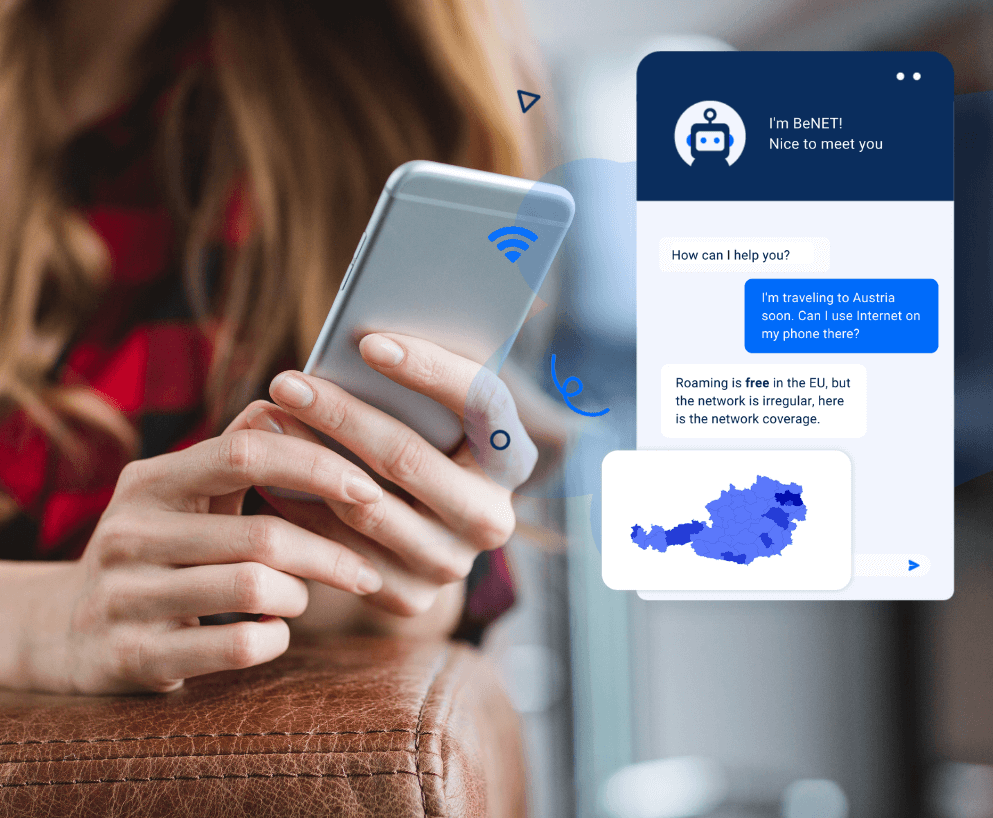This article has been written by Richard Conn, Senior Director of Demand Generation at 8×8.
In the last few years, the telecommunications industry has taken a significant hit in spending. 2020 saw spending drop to $1.3 trillion.
Fortunately, however, we can see a healthy recovery on the way. By 2023, we are expected to see growth rocket to nearly $1.5 trillion. But how exactly is the telecom industry adapting to the challenges of today’s market?
One answer is AI chatbots.

One of the biggest advantages of using AI technology is the incorporation of machine learning. In recent years, the ability of AI chatbots to comprehend speech and automate tasks has grown in leaps and bounds.
It’s already predicted that revenue for telecommunication AI technology is going to grow exponentially. By 2024, we might be looking at a $2.4 billion revenue forecast.
With innovations such as Alexa, Siri, and more, AI chatbots are increasingly being used to perform many menial and tedious tasks that used to bog down the service industry. From scheduling to account checks and top-ups, chatbots provide a way for customers to carry out a variety of service operations, without the need for a live agent.
This has empowered telecom companies to reduce their waiting times, decrease call volume and increase customer satisfaction.
So let’s discuss the reasons why it’s time for your telecom business to invest in chatbots.
What are AI chatbots?
Firstly, AI-powered chatbots are software applications that can be used instead of live caller agents. They operate using text-to-speech technology that can break down user responses, and respond appropriately.
Before the rise of chatbots, IVRs were the go-to solution for automating customer inquiries. Interactive voice response or IVR used a keypad system that would generate pre-recorded responses based on the numbers that a customer pressed on their phone.
Whilst this could help users to carry out basic tasks, IVRs were unable to perform complex functions or engage in complicated conversations. They often left customers feeling frustrated that they couldn’t carry out their tasks.
Enter the AI chatbot.
1. AI chatbots are better than IVRs
Unlike traditional IVRs, AI chatbots can carry out sentiment analysis. Sentiment analysis is designed to detect the mood and tone of a conversation. It can read nuances in pitch, responsiveness, and gauge how customers are feeling during a conversation.
Using these insights, businesses can become more receptive to how their customers are responding to their service. Empathy factors highly into whether a customer will leave a call experience feeling satisfied.
According to a recent report, 68% of customers expect call center businesses to show empathy. By enforcing a chatbot strategy, you can help your business to connect with customers on their level, whilst also benefiting your bottom line.
Hosted call center solutions can use chatbots to engage with thousands or even millions of customers at a time. By scaling operations in this way, it can greatly increase revenue.
Businesses can effectively provide remote assistance 24/7 in different countries and languages. This may also increase their global presence.
Telecommunication call centers are often inundated with repetitive requests around the clock. With chatbots, they can potentially filter through many of such calls with ease.
For example, chatbots can provide tech support and help to troubleshoot common user problems. When a caller dials in looking for an answer to a problem, it can guide them through a series of step-by-step solutions. But not only that, when a caller reports a problem on the network, the data is filtered through the chatbot. By integrating your AI with your business operations, it can alert technicians when problems arise. It can even provide recommendations and solutions.
Inbenta offers the perfect 4-in-1 AI platform for telecom companies. With our 4 modules (Chatbot, Knowledge, Search, and Messenger) powered by our patented Natural Language Processing technology, you get the best tool on the market to reduce and automate telecom support requests. Help your customers get answers to their questions, upgrade their plan, access their bills, set up calling features, check their balance, and more without agent intervention. Improve customer satisfaction and loyalty thanks to Inbenta.
2. Chatbots in telecom can drive sales
On the topic of revenue, AI chatbots are also key sales automation tools.
It’s important to know that customer experience can significantly affect your sales. For instance, more than 90% of customers are more likely to purchase from a company when they have had a positive customer service experience.
In addition to resolving customer issues, AI chatbots can leverage customer data to increase sales. One way they do this is by creating a personalized experience for the customer.
AI chatbots are often used in tandem with a CRM system. CRMs are repositories of customer data. Using cloud call center software, businesses can link all their operations through an online network.
This allows the AI to access account information on interests, previous purchases, and buying behavior of customers. By utilizing this information, they can pitch the best promotions and upselling techniques to your customers. They can make their offers highly relevant to a customer’s needs.
For instance, if a caller is regularly exceeding their data plan, it can suggest a better plan from their service. Moreover, it can walk them through the process of upgrading their plan, and recording it on the system.
The chatbots can both collect new data and also use it to create better solutions, whilst offering proactive support and recommendations to the customer if the circumstance is viable to do so.
3. Telecom chatbots can reduce call time
Another noteworthy feature of chatbots in the telecom industry is their ability to schedule and manage customer accounts. With chatbots, users can:
- Manage canceling, upgrading or modifying a service
- Have billing questions, and payment information answered
- Manage account terminations
- Book in scheduled repairs or technician’s appointments
The idea behind offering these services is that many customers prefer self-service. 82% of customers already use or are interested in using chatbot self-service to carry out basic tasks.
With a robust chatbot self-service system, businesses can cut down on customer waiting time. This is especially true for telecom call centers that manage high volumes of calls. A common complaint with customer service is a lack of speedy response, and effectiveness.
The most frustrating aspect of customer service (Hubspot)
- 33% waiting on hold
- 33% repeating yourself to different agents
- 19% slow response time
- 14% not being able to resolve an issue through self-service
- 1% other
By responding to these complaints, you can improve customer satisfaction. For example, with ACD telephone systems (automatic call distribution), you can cut wait time by quickly directing customers to the self-service system.
4. Chatbots can improve telecom customer satisfaction
So far we’ve talked about the benefits of chatbots, but to put these features in context, the key aspect behind these findings are overall customer experience, and satisfaction.
More than 45% of businesses believe customer experience is crucial to their performance. This is in part because customer expectations are changing.
More and more customers expect high levels of customer experience from their interactions with call centers. 72% of customers say “the experience a company provides is as important as its products/services”. So how should call centers respond to this trend?
The latest AI chatbot innovations use a technology called NLP – Natural Language Processing. NPL AI is designed to interpret, and extract meaningful data from customer conversations.
Conversational bots can process high-level semantic, and linguistic cues. By gaining a thorough understanding of customers, they conduct better interactions with callers.
In the US, the telecommunication churn rate reached 21% at the beginning of 2020. In answer to this problem, many businesses are looking to personalize the customer experience.
But how can chatbots achieve this?
5. Chatbots in telecom can improve engagement
Personalized customer experience comes down to knowing your audience.
52% of customers expect offers to always be personalized. To meet this demand, businesses need clear analytical data that can inform them of the individual needs of consumers. As mentioned, AI bots use machine learning to gain an understanding of customer interactions. The more they talk with customers, the more they learn about them.
Add this to a CRM database, and AI can extrapolate relevant user data into actionable insights. It can look at the frequency of purchases, customer engagement with particular services, and demographic knowledge to customize the customer experience accordingly.
Moreover, this data can become a part of your customer segmentation effort. With A/B testing, AI can learn about the preferences of different, and individuals that it can use to then personalize conversations.
The benefits of this approach were studied in a recent survey of personalized customer experience.
Perceived benefits of a personalized experience (2021 study).
- 28.5% relevance
- 26.3% product value
- 24% economic value
- 18% convenience
The study concluded that relevance was one of the key benefits of a personalized customer experience. It reduces the number of irrelevant recommendations, adds convenience, and saves them money. With this motivation, customers are more likely to engage with brands. And this means businesses have a better chance of satisfaction and conversion.
Conclusion
So that’s a little more information on the benefits of AI chatbots in the telecom industry. As discussed, AI chatbots are leading the way in the telecom market.
While investing in AI software can be intimidating, in many cases the benefits often outweigh the risk. Businesses can capitalize on automating their systems around the customer’s needs.
From increasing your revenue to improving customer satisfaction, the possibilities will only grow as technology advances. In short, there’s never been a better time to make the transition to AI technology.
Richard Conn – Senior Director, Demand Generation, 8×8
Richard Conn is the Senior Director for Demand Generation at 8×8, a leading XCaaS infrastructure communication platform with integrated contact center, voice, video, and chat functionality. Richard is an analytical & results-driven digital marketing leader with a track record of achieving major ROI improvements in fast-paced, competitive B2B environments. Here is his LinkedIn.










